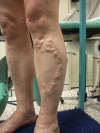CHIVA to treat saphenous vein insufficiency in chronic venous disease: characteristics and results
- PMID: 31191629
- PMCID: PMC6542318
- DOI: 10.1590/1677-5449.009918
CHIVA to treat saphenous vein insufficiency in chronic venous disease: characteristics and results
Abstract
There is considerable debate in the literature with relation to the best method to treat patients with chronic venous disease (CVD). CHIVA is an office-based treatment for varicose veins performed under local anesthesia. The aim of the technique is to lower transmural pressure in the superficial venous system and avoid destruction of veins. Recurrence of varicosities, nerve damage, bruising and suboptimal aesthetic results are common to all treatments for the disease. This paper evaluates and discusses the characteristics and results of the CHIVA technique. We conclude that CHIVA is a viable alternative to common procedures that is associated with less bruising, nerve damage, and recurrence than stripping saphenectomy. The main advantages are preservation of the saphenous vein, local anesthesia, low recurrence rates, low cost, low pain, and no nerve damage. The major disadvantages are the learning curve and the need to train the team in venous hemodynamics.
Existe uma grande discussão na literatura sobre o tratamento da doença venosa crônica (DVC). A cura conservadora e hemodinâmica da insuficiência venosa em ambulatório (CHIVA) consiste no tratamento ambulatorial de varizes sob anestesia local. O objetivo da técnica é diminuir a pressão transmural no sistema venoso superficial para evitar a destruição das veias, incluindo as veias safenas. Recorrência de varizes, lesão de nervos, hematomas e resultado estético abaixo do ideal são uma constante em todos tratamentos de varizes. O objetivo desta revisão é avaliar e discutir a técnica CHIVA quanto a suas características e resultados. A CHIVA é uma alternativa válida frente aos outros procedimentos, apresentando menos hematomas, recorrência e lesão nervosa que a safenectomia. Preservação da veia safena, anestesia local, baixa taxa de recorrências, baixo custo, pouca dor e ausência de lesões nervosas são as principais vantagens. A longa curva de aprendizado para treinar a equipe em hemodinâmica venosa é a principal desvantagem.
Keywords: CHIVA; chronic venous disease; local anesthesia; saphenous sparing; varicose vein.
Conflict of interest statement
Conflicts of interest: No conflicts of interest declared concerning the publication of this article.
Figures



References
-
- Franceschi C. Théorie et pratique de la cure conservatrice et hémodynamique de l'insuffisance veineuse en ambulatoire. Précy-sous-Thil: Editions de l’Armançon; 1988.
-
- Franceschi C, Zamboni P. Principles of venous hemodynamics. New York: Nova Biomedical Books; 2009.
-
- Franceschi C, Cappelli M, Ermini S, et al. CHIVA: hemodynamic concept, strategy and results. Int Angiol. 2016;35(1):8–30. - PubMed
-
- Zamboni P, Mendoza E, Gianesini S. Saphenous vein-sparing strategies in chronic venous disease. Cham: Springer; 2018. 289. - DOI
-
- Zamboni P, Marcellino MG, Cappelli M, et al. Saphenous vein sparing surgery: principles, techniques and results. J Cardiovasc Surg. 1998;39(2):151–162. - PubMed
Publication types
LinkOut - more resources
Full Text Sources
